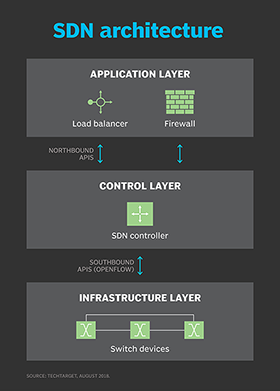What is a programmable network (network programmability)?
A programmable network is one in which software that operates independently of network hardware handles the behavior of network devices and flow control. The fundamental nature of programmable networks is to separate the underlying physical hardware from the control software of a device.
Traditional networks vs. programmable networks
In traditional IT networks, physical hardware such as routers, switches and firewalls must be manually configured and individually managed. This requires a lot of human intervention and manual effort. IT teams can expend this if the network is small or the organization's networking needs are less complex. However, for large, complex networks, manual configurations and management can be time-consuming and extremely onerous for IT teams.
Another characteristic of traditional networks is that troubleshooting happens on a case-by-case basis. This makes it difficult to detect and diagnose issues affecting multiple devices. It also increases resolution times and network downtime. Visibility into network health is extremely limited in these networks, necessitating additional tools to monitor the network and its operations, which translates into increased expense and management overhead.
To address these issues, programmable or software-defined networks can be the change that resource-constrained IT teams need. A single entity using specialized software controls these networks. IT personnel do not need to individually configure, manage or troubleshoot devices and services, so they can deploy these elements quickly and manage them easily, regardless of changing user needs or increasing network complexity. They can also implement centralized policies to manage traffic flows and monitor real-time network conditions.
Network programmability: What does it mean and how does it relate to software-defined networking?
Network programmability enables the separation of network hardware from the control software. The software has a broader view of the network, creating a proverbial 10,000-foot overview. With network programmability, software can be programmed in one place, using a controller to orchestrate the configuration of the network's other hardware devices.
This development led to the creation of software-defined networking (SDN), which has now largely supplanted the generic term programmable networks.
Characteristics of programmable networks
The most essential characteristic of a programmable network is that it can be centrally defined and managed with software. Most programmable networks use open network interfaces and development tools, enabling them to be programmed easily, extended securely and controlled.

Since hardware limitations do not rigidly confine programmable networks, they are more agile and scalable. They can easily adopt and incorporate new features and innovative technologies to meet an organization's current and future needs.
Using application programming interfaces frees networks to adopt new architectures and protocols. The APIs also facilitate interactions between the network hardware and software. This simplifies network management and control, and creates opportunities for automating the network and increasing responsiveness, flexibility and efficiency.
In recent years, predictive analytics platforms based on AI and machine learning have emerged to simplify maintenance further and improve the performance and security of SDN . These platforms also support proactive handling of network issues and ensure high performance and low latency for critical applications.
Finally, programmable networks tend to be more secure than traditional networks. Administrators can use centralized templates, widely accepted best practices and checkpoints to maintain consistent configurations and alleviate security threats. Automated checks can reduce the risk of human error and minimize the potential for network downtime.
History of network programmability
When the concept of programmable networks emerged, it was a radical innovation. Traditionally, network admins configured each network device independently of others. They used the command-line interface (CLI) to type hundreds of commands, one by one, until a group of devices passed traffic as intended.
In those days, automation involved onerous scripting languages or cutting and pasting. Admins might cut and paste changing localized device information, such as IP addresses. With the exponential growth of networks, this became untenable.
Today, network automation and programming are easier than ever, thanks to the separation between transmission hardware and control software as well as the virtualization of networking infrastructure. The availability of open, programmable network interfaces helps organizations deploy new services easily to satisfy business or user demands. Programmability also simplifies device configurations, network troubleshooting and centralized policy implementation.
Fundamental elements of programmable networks
All programmable networks rely on a few fundamental elements:
Protocols
Network admins can control and program networks from one place and time using protocols like OpenFlow and other open and proprietary standards. All underlying hardware works together as if someone had punched in all those CLI commands on each device. This means scalable networks can have sufficient size and scope to support growing cloud and containerization workloads that put more stress on infrastructure.
APIs
Programmable networks also facilitated the advancement of APIs that enable one piece of software to talk to another.
Controllers use APIs to speak to devices under their control. Industry-standard RESTful APIs can provide access to the software controller so that anyone can write custom software to orchestrate a programmable network.
Infrastructure as code
Using APIs to control networks is now commonplace. The scale and scope of modern networks makes device-by-device configuration impractical in any but the smallest of networks.
With enterprises embracing virtualization, containerization and cloud deployments, a concept called infrastructure as code has taken hold. IaC involves using software to build a network completely from the ground up, including storage and compute, on top of an abstracted hardware layer. By using software code instead of manual configurations, IaC can automate the deployment of network configurations. This accelerates configurations while accommodating scalable deployments and a more agile IT environment.
SDN controllers
SDN controllers play an important role in reducing the risk of human error in network configuration and management. They do this by automatically applying logic checks before configurations are pushed live. They also can configure devices from a single pane of glass interface, ensuring configuration consistency and centralized management while minimizing the need for human intervention.
Controllers continuously monitor the network and provide real-time visibility into its overall health and performance. This helps identify and address issues early.
Uses of programmable networks
Programmable networking is particularly useful in data centers where complex interconnections and traffic patterns are the norm. There, using software, APIs, and an open ecosystem of tools, interfaces and technologies helps improve bandwidth management, security and resource allocation.
SDN is also suitable for internet of things (IoT) and telecommunications applications. Programmability facilitates building a complex infrastructure for handling many connected devices in IoT networks and simplifies infrastructure management for telecom networks.
Cloud computing is another key use case for programmable networks. Through software, network managers can create flexible virtual networks where resources can be added or removed quickly in response to fast-changing needs.
Benefits of programmable networks
Programmable networking has several benefits over traditional networking:
- Reduced long-term costs.
- Applications able to maintain information about device capabilities.
- Networks able to respond to application status and resource requirements.
- Better allocation of bandwidth and resources.
- Faster network deployments.
- Improved network performance and reduced downtime.
- Packet prioritization for traffic shaping.
- Improved operational flexibility and enhanced transparency.
Programmable networks are also more scalable and enduring, enabling organizations to adapt easily to evolving business circumstances and use new technologies.
Further explore the role of network virtualization and SDN in data centers and learn more about how infrastructure as code can help streamline development and deployment with this comparison of eight IaC tools.






